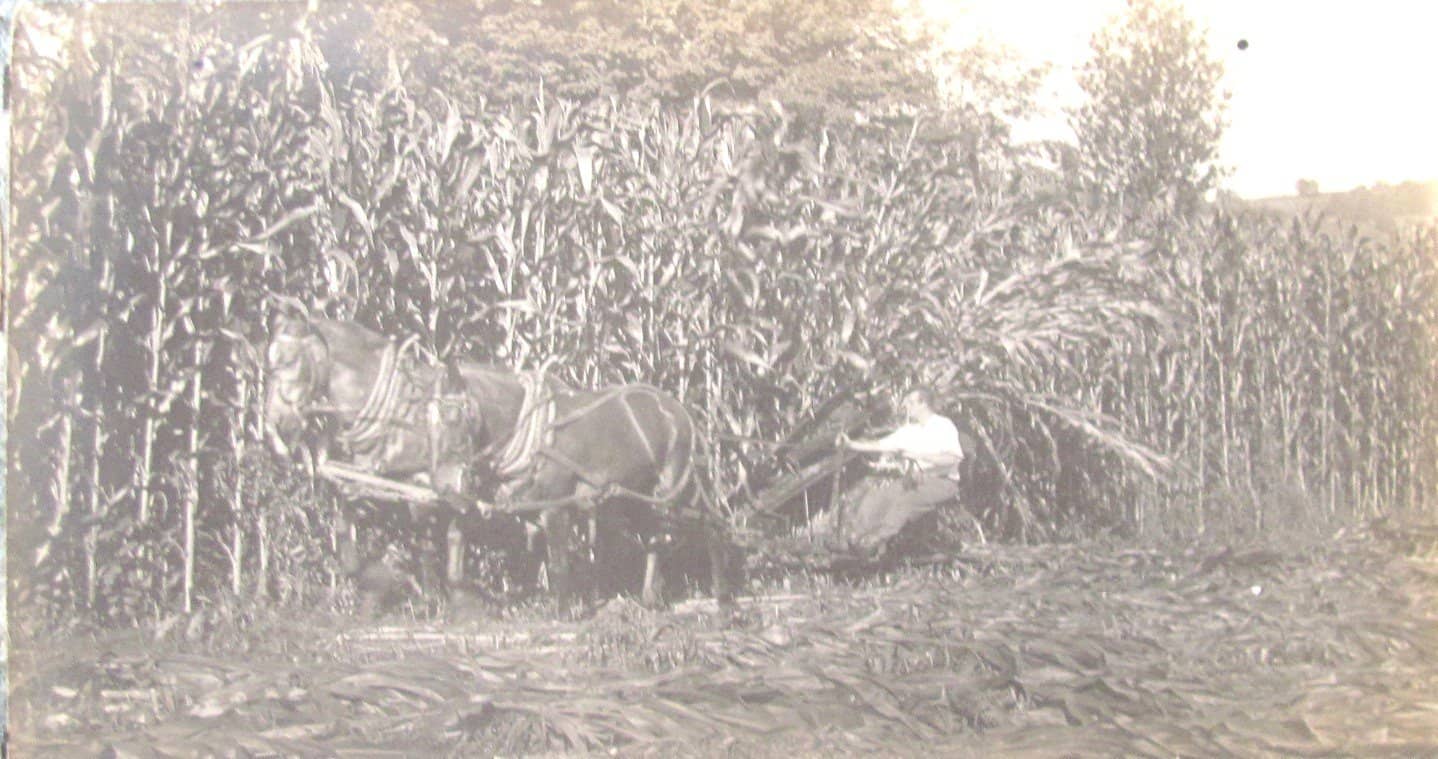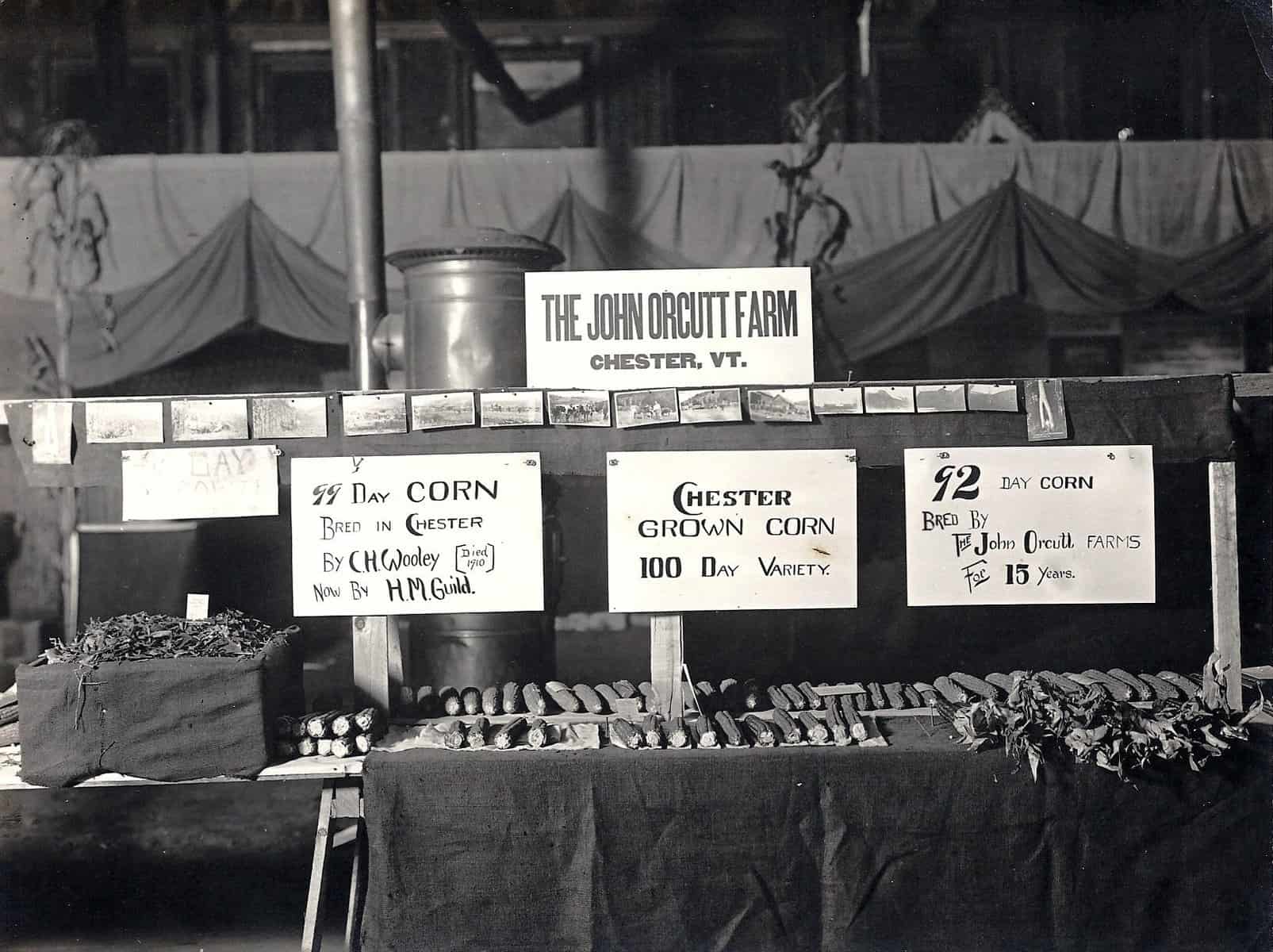
Some will remember Bill and Marjorie Orcutt. The Orcutts were a wealthy family who originally lived where Stone Hearth Inn is. Bill’s grandfather was John C. Orcutt.
John C. Orcutt was experimenting with different hybrid corns in the early 1900s. Because he was wealthy, he bought the latest, most advanced farm equipment.
At the historical society is a photo showing ears of corn grown by John C. Thankfully I had a copy on my computer. This photo now has more meaning. I’ll get to this in a bit.
A while back, I picked up three old postcards showing John C. Orcutt harvesting corn. All three were taken by Charles Wellman in 1910. I will call them numbers one, two, and three.
Number one is the photo with this article. Each postcard has information written on the reverse. Number one reads: “Please return to John C. Orcutt – Chester-Vt. This shows McCormick Binder in action about to release a tied bundle. Note horse’s feet, this picture taken when machine was in action.”
Number two reads: “Year 1910 (Please return-to-John Orcutt Chester-Vt.)
Eureka ensilage Corn planted on June 3d cut Sept. 2d, Yield 20 tons per acre 100 tons of corn on 5 acre field. Cut with a McCormick Corn Binder.”
Number three simply reads: “Please return to John C. Orcutt Chester, Vt.”
Number one, the photo with this article, is impressive. John C. sits on the corn binder drawn by two horses. Notice how tall the corn is. It must be 12 feet tall. To think the corn reached this height in just three months is amazing. This is the corn that was being hybridized right here in Chester.
If you look directly behind John C., you’ll notice the cut cornstalks falling to the right. There’s a tray-like affair the cornstalks drop in. Then it was bound with something like baling twine.
The cutter was similar to a sickle bar. Mechanically powered by gears, driven by the rotation of the wheels, the corn was cut and bound into neat bundles. This was advanced technology for the day.
CHS photo

The 1911 CHS photo I will describe. It shows Orcutt’s vendor booth at a fair. The fair might have been the Chester Fair on Blue Hill road, close to Orcutt’s farm.
At the top of the photo is a sign, “The John Orcutt Farm, Chester, Vt.” Below is a counter with husked ears of corn. There are three signs above the counter, side-by-side, describing the different corn.
Left is: “99 day corn, bred in Chester, by C.H. Wooley [died 1910] now by H.M. Guild.”
The middle sign: “Chester grown corn, 100 day variety.”
The third sign reads: “92 day corn bred by John Orcutt Farms for 15 years.”
The “John Orcutt Farm, Chester, Vt.” sign rests on a shelf at top. On the edge of the wooden shelf, many postcards are tacked. When I enlarge the photo, the three postcards I have can be seen.
There is also a vertical postcard showing John C. standing in front of an ancient hollowed out maple tree. The historical society has this same postcard.
Marjorie Orcutt was our history and civics teacher at Chester High School. Many will remember her. When Ted Spaulding was in high school, she was Marjorie Alexander. She would later marry Bill.
Bill was a Yale graduate and forester/lumberman in Maine and Vermont. He and his family owned 2,000 or more acres, including the Pinnacle. Most of the acreage was up Lovers Lane. Bill also owned property in Connecticut and Hawaii.
Bill was an antiques dealer, so our paths often crossed. I remember going to see Bill to sell him something I had just bought. Bill wanted it and said, “Take it easy on me. I’m a poor man.”
From donations from Ted and Gramp Spaulding were many old scrapbooks. Some of these scrapbooks I numbered. Each page was given a number. I have digital copies of some scrapbooks. In scrapbook #1, page 25, is John C. Orcutt’s obituary. More needs to be done.
I found this corn history fascinating. Who knew?
This week’s old saying: “Money can’t buy happiness, but somehow it’s more comfortable to cry in a Corvette than in a Yugo.”